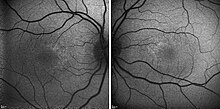Hypotrichosis with juvenile macular dystrophy
Hypotrichosis with juvenile macular dystrophy ( HJMD or CDH3 ) is an extremely rare congenital disease characterized by sparse hair growth ( hypotrichosis ) from birth and progressive macular dystrophy .
frequency
Their total frequency is estimated to be far less than 1: 1,000,000, so far only about 50 to 100 cases have been described.
root cause
The disease is autosomal - recessive inherited. The cause is mutations in the CDH3 gene , which codes for the cadherin -3 protein (P-cadherin), a calcium-binding protein that is responsible for cell contact in different tissues . There is complex heterozygosity .
Clinical appearance
The main hair is not, as usual, full and its growth is very weak, the rest of the body has normal hair systems. By the time they start school at the latest, the visual impairment is also noticeable to outsiders.
The macular degeneration shows itself in a slow u. U. also progressive deterioration of the central vision, later with loss of reading ability. Otherwise, those affected can develop completely healthy and have a normal life expectancy.
Diagnostics and early detection
If the hair anomaly is noticeable, it should lead to an ocular fundoscopy at the latest when starting school , as the usual preventive examinations cannot necessarily detect impaired vision .
Confirmation of the diagnosis is only possible through molecular genetic diagnostics as part of human genetic counseling and is a prerequisite for possible future therapy options.
Recommended examination method for progress diagnosis
The extent of the damage to the retina is assessed using fluorescence angiography , retinal scans and optical coherence tomography ; electrophysiological examinations such as the Ganzfeld electroretinogram (ERG) or the multifocal electroretinogram (mfERG) can also be used.
Differential diagnostics
Hair shaft anomalies in the context of ectodermal dysplasia are to be distinguished . Changes in the CDH3 gene can also occur in EEM syndrome .
therapy
There is currently no causal treatment available, but a large number of studies in the areas of gene therapy , exon skipping and CRISPR / Caszarte meanwhile offer hope on the horizon. A precise determination of the gene mutation through reliable diagnostics also offers further potential approaches beyond gene replacement for a specific group - in the case of a diagnosed so-called nonsense mutation, a mutation in which a stop codon is created by exchanging a single base in the DNA sequence . This leads to the premature chain termination in protein synthesis. This results in a shortened, functionless or functionally inferior protein. Translational skipping of a stop codon, the so-called "read-through therapy", can cause the administration of certain substances to skip stop codons and thus lead to a usable protein. However, this approach is only conceivable for very limited mutations that cause different diseases.
Help with coping with illness and life planning
A disease that threatens the eyesight and also shows a hair anomaly that is recognizable to strangers, injures people not only physically, but always in their entirety. It is therefore not surprising that the opening of the diagnosis amounts to a shock for the patient concerned. This applies equally to affected children as it does to parents and relatives. One is confronted with the statement that there is currently no treatment option. You never feel lonely and abandoned in your life. The questions arise: “Why only me or why my child?” However, there is always hope and, especially with affected children, a happy childhood should be the first priority. Too many examinations and doctor's appointments cost time and will not be able to solve the problem of a gene mutation practically in a few months. It is therefore advisable that the parents treat their child with empathy, but educate them in such a way that they can mature independently and confidently into their teenage years. Dealing openly with the disease and exchanging experiences with those affected, even if it is unlikely to meet someone in person given the rarity of the disease, help to cope with life together.
history
The first description comes from 1935 by the German doctor Hans Wagner.
literature
- A Rare Syndrome: Hypotrichosis with Juvenile Macular Dystrophy (HJMD)
- CADHERIN 3. In: Online Mendelian Inheritance in Man . (English)
- L. Samuelov, E. Sprecher, D. Tsuruta, T. Bíró, JE Kloepper, R. Paus: P-cadherin regulates human hair growth and cycling via canonical Wnt signaling and transforming growth factor-β2. In: Journal of Investigative Dermatology . 2012, Volume 132, No. 10, pp. 2332-2341, doi: 10.1038 / jid.2012.171 , PMID 22696062 .
- K. Nagel-Wolfrum, F. Möller, I. Penner, U. Wolfrum: Translational read-through as an alternative approach for ocular gene therapy of retinal dystrophies caused by in-frame nonsense mutations. In: Visual neuroscience. Vol. 31, No. 4-5, September 2014, pp. 309-316, doi: 10.1017 / S0952523814000194 , PMID 24912600 (review).
- Manuel Jose Justiniano: Micro Perforations Deep Sclerectomy (MPDS). In: Journal of Clinical & Experimental Ophthalmology. 06, 2015, doi: 10.4172 / 2155-9570.S1.022 .
- CY Gregory-Evans, X. Wang, KM Wasan, J. Zhao, AL Metcalfe, K. Gregory-Evans: Postnatal manipulation of Pax6 dosage reverses congenital tissue malformation defects. In: The Journal of clinical investigation. Vol. 124, No. 1, January 2014, pp. 111–116, doi: 10.1172 / JCI70462 , PMID 24355924 , PMC 3871240 (free full text).
- N. Schwarz, A.-J. Carr et al. a .: Translational read-through of the RP2 Arg120stop mutation in patient iPSC-derived retinal pigment epithelium cells. In: Human Molecular Genetics. 24, 2015, p. 972, doi: 10.1093 / hmg / ddu509 .
Individual evidence
- ↑ Hypotrichosis - juvenile macular degeneration. In: Orphanet (Rare Disease Database).
- ↑ H. Wagner: Maculaaffektion, associated with Haarabnormitat of Lanugotypus, both innate perhaps in two siblings . In: Graefes Archive Clinical and Experimental Ophthalalmology, Vol. 134 , 1935, pp. 74-81.




